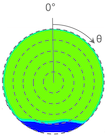
To reduce the carbon footprint of the future air transport system, it is inevitable to radically improve the aircraft and propulsion efficiency. This should not only reduce the fuel consumption but also enable the usage of new game-changing technologies (i.e. electric engines). For significantly reducing the total energy demand of the aircraft, new approaches have to be taken account of. Boundary layer ingestion (BLI) is considered to be such a promising method to improve the efficiency of future aircraft. By increasing the momentum of the aircraft boundary layer flow the propulsion efficiency can increase and thereby save propulsive energy. Due to the close coupling of BLI to other aircraft drag reduction measures like aircraft active laminar flow control (LFC) on both, wing and aircraft body, both effects have to be assessed in parallel for maximising the overall aircraft benefit. As this directly effects the propagation of the airframe boundary layer sucked into the embedded propulsion system, obviously, an interaction has to be considered.
On the other hand BLI-based power saving does only work if the propulsor itself, i.e., the fan, will not be adversely affected be the incoming inhomogeneous flow. Therefore, effective ROM (Reduced Order Modells) supported by detailed validation studies of partially embedded BLI engines plus LFC are required. The proposed research project covers investigations with analytical tools and detailed high-fidelity numerical simulations of asymmetric BLI configurations with integrated UHBR propulsors. The synergies of BLI and LFC are mainly examined with an enhanced parallel compressor method (PCM) in order to identify an optimum configuration. State-of-the-art RANS simulations are carried out to analyse the sensitivities of boundary layer ingestion on the aircraft and the propulsion side of a blended wing body (BWB) aircraft configuration with a rear mounted propulsor array.
Due to the unsteady interaction of the propulsor with a local incoming BLI flow field, asymmetric BLI represents also a new noise source on propulsion and aircraft level. Hence, URANS simulations of selected configurations will also generate high-fidelity flow field data for acoustic analysis within SE²A.
